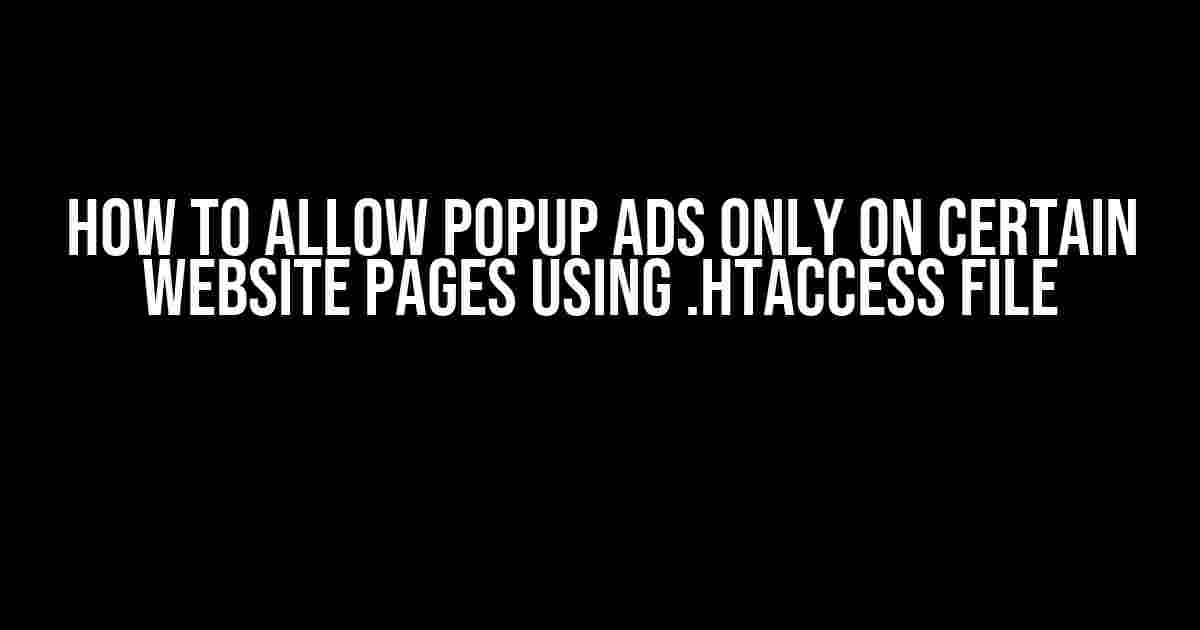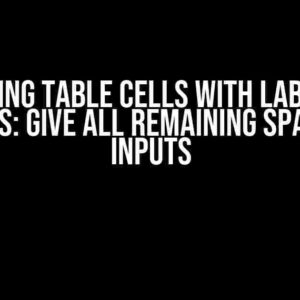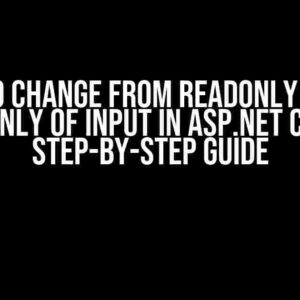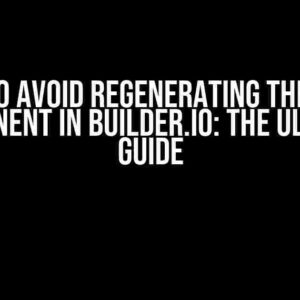Introduction
Popup ads – the bane of many website visitors’ existence. While they can be an effective way to monetize your website, they can also be incredibly annoying if not implemented carefully. One common complaint is that popup ads can appear on every page of a website, disrupting the user experience and driving visitors away. But what if you could control when and where popup ads appear on your website? In this article, we’ll show you how to allow popup ads only on certain website pages using the .htaccess file.
Why Use .htaccess?
Before we dive into the tutorial, let’s take a step back and explain why we’re using the .htaccess file to control popup ads. The .htaccess file is a powerful tool that allows you to manipulate how your website interacts with visitors and search engines. By adding custom rules to this file, you can control everything from URL redirects to caching, and even popup ads.
Using .htaccess has several advantages:
- Easy to implement**: You don’t need to be a coding expert to add rules to your .htaccess file. A basic understanding of Apache syntax is all you need.
- Flexible**: You can customize your .htaccess file to fit your specific needs, whether that’s blocking certain IP addresses or controlling popup ads.
- Server-side control**: Since .htaccess is a server-side file, you have more control over how your website behaves, even if a visitor has JavaScript disabled.
Step 1: Create a Backup of Your .htaccess File
Before we start making changes to your .htaccess file, it’s essential to create a backup in case something goes wrong. You can do this using an FTP client or file manager in your hosting control panel.
Connect to your website’s root directory and look for the .htaccess file. Right-click (or control-click on a Mac) and select “Download” or “Copy” to create a local copy of the file.
Step 2: Identify the Pages Where You Want to Allow Popup Ads
Next, identify the specific pages where you want to allow popup ads. This could be a single page, a category of pages, or an entire section of your website. Make a note of the URLs or patterns that match these pages.
Example:
Let’s say you want to allow popup ads on all pages in the “/resources” directory, but not on any other pages. You would make a note of the URL pattern:
/resources/*
Step 3: Add the Popup Ad Code to Your Website
Add the popup ad code to your website, but wrap it in a conditional statement that checks for the presence of a specific cookie. This cookie will be set only on the pages where you want to allow popup ads.
In this example, we’ll use a JavaScript code that sets a cookie named “popup_allowed” with a value of “true” on the pages where popup ads are allowed:
<script>
if (window.location.pathname.indexOf("/resources/") !== -1) {
document.cookie = "popup_allowed=true; expires=Fri, 31 Dec 9999 23:59:59 GMT; path=/";
}
</script>
This code checks if the current URL contains the “/resources/” pattern, and if so, sets the “popup_allowed” cookie.
Step 4: Add the .htaccess Rules
Now, add the following rules to your .htaccess file to allow popup ads only on the pages where the “popup_allowed” cookie is set:
<IfModule mod_setenvif.c>
<If "req('cookie_popup_allowed') == 'true'">
Header set X-Popup-Ads "allowed"
</If>
</IfModule>
This code uses the mod_setenvif module to check the value of the “popup_allowed” cookie. If the cookie is set to “true”, it sets an HTTP header named “X-Popup-Ads” with a value of “allowed”. This header will be used to trigger the popup ad code.
Step 5: Configure Your Popup Ad Code
Finally, update your popup ad code to check for the presence of the “X-Popup-Ads” header before displaying the ad:
<script>
if (document.cookie.indexOf("popup_allowed=true") !== -1 && "allowed" === document.getResponseHeader("X-Popup-Ads")) {
// Display the popup ad code here
}
</script>
This code checks both the “popup_allowed” cookie and the “X-Popup-Ads” header before displaying the popup ad. If either condition is not met, the ad will not be displayed.
Conclusion
By following these steps, you can control when and where popup ads appear on your website using the .htaccess file. This technique gives you more flexibility and control over your website’s user experience, while also ensuring that you don’t annoy your visitors with excessive popup ads.
Remember to test your implementation thoroughly to ensure that the popup ads are appearing only on the pages where you intend them to.
Troubleshooting Tips
If you encounter any issues with this implementation, here are some troubleshooting tips to help you:
- Check your .htaccess file syntax**: Make sure you’ve added the rules correctly and there are no syntax errors.
- Verify the cookie is being set**: Use a browser extension like Cookies Editor or EditThisCookie to verify that the “popup_allowed” cookie is being set correctly.
- Check the HTTP headers**: Use a tool like cURL or the Network Inspector in your browser’s DevTools to verify that the “X-Popup-Ads” header is being sent correctly.
| URL Pattern | Popup Ads Allowed? |
|---|---|
| /resources/abc | Yes |
| /blog/def | No |
| /resources/ghi | Yes |
By following these steps and troubleshooting tips, you should be able to implement a popup ad system that is both effective and respectful of your visitors’ experience.
Frequently Asked Question
Are you tired of popup ads taking over your website? Want to know how to control when and where they appear? Look no further! We’ve got the answers to your .htaccess file questions.
How do I allow popup ads only on certain website pages using .htaccess file?
To allow popup ads on specific pages, you’ll need to add a few lines of code to your .htaccess file. First, identify the pages where you want to allow popup ads. Then, add the following code: `RewriteCond %{REQUEST_URI} ^/(page1|page2|page3) [NC]` and `RewriteRule .* – [E=ALLOW_POPUPS:1]`. Replace `page1`, `page2`, and `page3` with the actual page URLs. This code sets an environment variable `ALLOW_POPUPS` to `1` only on the specified pages.
What’s the purpose of theRewriteCond and RewriteRule directives in the .htaccess file?
The `RewriteCond` directive sets a condition that must be met before the `RewriteRule` is applied. In this case, it checks if the requested URL matches one of the specified pages. The `RewriteRule` directive then sets the environment variable `ALLOW_POPUPS` to `1` if the condition is true. This allows you to control the popup ads based on the page being visited.
How do I integrate the .htaccess code with my popup ad script?
To integrate the .htaccess code with your popup ad script, you’ll need to modify the script to check for the `ALLOW_POPUPS` environment variable. For example, you can add a conditional statement in your script to check if `ALLOW_POPUPS` is set to `1` before displaying the popup ad. This ensures that the ad only appears on the specified pages.
Will this .htaccess code work on all types of popup ads?
The .htaccess code provided is a general solution, but it may not work with all types of popup ads. Some popup ad scripts may use different methods to display ads, so you may need to modify the code or the script to integrate them correctly. Additionally, some ad networks may have specific requirements for displaying ads, so be sure to check their documentation before implementing this solution.
Are there any security concerns I should be aware of when using this .htaccess code?
When using this .htaccess code, be aware that you’re setting an environment variable that can be accessed by your popup ad script. This could potentially allow malicious scripts to exploit the variable. To minimize the risk, make sure to limit access to the `ALLOW_POPUPS` variable and ensure that your popup ad script is secure and properly validated.






